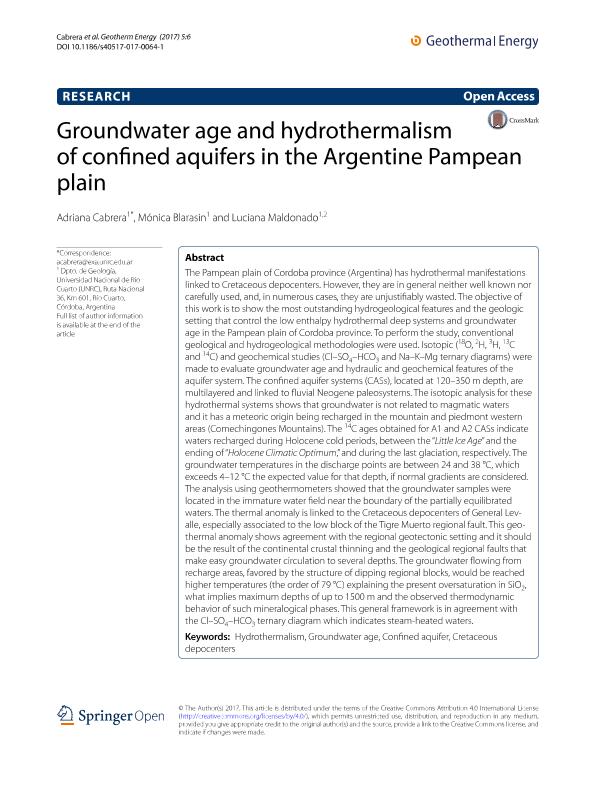Mostrar el registro sencillo del ítem
dc.contributor.author
Cabrera, Adriana Edith

dc.contributor.author
Blarasin, Mónica Teresa

dc.contributor.author
Maldonado, Marina Luciana

dc.date.available
2019-04-26T18:18:12Z
dc.date.issued
2017-12
dc.identifier.citation
Cabrera, Adriana Edith; Blarasin, Mónica Teresa; Maldonado, Marina Luciana; Groundwater age and hydrothermalism of confined aquifers in the Argentine Pampean plain; SpringerOpen; Geothermal Energy; 5; 1; 12-2017
dc.identifier.uri
http://hdl.handle.net/11336/75126
dc.description.abstract
The Pampean plain of Cordoba province (Argentina) has hydrothermal manifestations linked to Cretaceous depocenters. However, they are in general neither well known nor carefully used, and, in numerous cases, they are unjustifiably wasted. The objective of this work is to show the most outstanding hydrogeological features and the geologic setting that control the low enthalpy hydrothermal deep systems and groundwater age in the Pampean plain of Cordoba province. To perform the study, conventional geological and hydrogeological methodologies were used. Isotopic ( 18 O, 2 H, 3 H, 13 C and 14 C) and geochemical studies (Cl–SO 4 –HCO 3 and Na–K–Mg ternary diagrams) were made to evaluate groundwater age and hydraulic and geochemical features of the aquifer system. The confined aquifer systems (CASs), located at 120–350 m depth, are multilayered and linked to fluvial Neogene paleosystems. The isotopic analysis for these hydrothermal systems shows that groundwater is not related to magmatic waters and it has a meteoric origin being recharged in the mountain and piedmont western areas (Comechingones Mountains). The 14 C ages obtained for A1 and A2 CASs indicate waters recharged during Holocene cold periods, between the “Little Ice Age” and the ending of “Holocene Climatic Optimum,” and during the last glaciation, respectively. The groundwater temperatures in the discharge points are between 24 and 38 °C, which exceeds 4–12 °C the expected value for that depth, if normal gradients are considered. The analysis using geothermometers showed that the groundwater samples were located in the immature water field near the boundary of the partially equilibrated waters. The thermal anomaly is linked to the Cretaceous depocenters of General Levalle, especially associated to the low block of the Tigre Muerto regional fault. This geothermal anomaly shows agreement with the regional geotectonic setting and it should be the result of the continental crustal thinning and the geological regional faults that make easy groundwater circulation to several depths. The groundwater flowing from recharge areas, favored by the structure of dipping regional blocks, would be reached higher temperatures (the order of 79 °C) explaining the present oversaturation in SiO 2 , what implies maximum depths of up to 1500 m and the observed thermodynamic behavior of such mineralogical phases. This general framework is in agreement with the Cl–SO 4 –HCO 3 ternary diagram which indicates steam-heated waters.
dc.format
application/pdf
dc.language.iso
eng
dc.publisher
SpringerOpen
dc.rights
info:eu-repo/semantics/openAccess
dc.rights.uri
https://creativecommons.org/licenses/by-nc-sa/2.5/ar/
dc.subject
Confined Aquifer
dc.subject
Cretaceous Depocenters
dc.subject
Groundwater Age
dc.subject
Hydrothermalism
dc.subject.classification
Meteorología y Ciencias Atmosféricas

dc.subject.classification
Ciencias de la Tierra y relacionadas con el Medio Ambiente

dc.subject.classification
CIENCIAS NATURALES Y EXACTAS

dc.title
Groundwater age and hydrothermalism of confined aquifers in the Argentine Pampean plain
dc.type
info:eu-repo/semantics/article
dc.type
info:ar-repo/semantics/artículo
dc.type
info:eu-repo/semantics/publishedVersion
dc.date.updated
2019-04-16T20:38:33Z
dc.identifier.eissn
2195-9706
dc.journal.volume
5
dc.journal.number
1
dc.journal.pais
Estados Unidos

dc.description.fil
Fil: Cabrera, Adriana Edith. Universidad Nacional de Río Cuarto. Facultad de Ciencias Exactas, Fisicoquímicas y Naturales. Departamento de Geología; Argentina
dc.description.fil
Fil: Blarasin, Mónica Teresa. Universidad Nacional de Río Cuarto. Facultad de Ciencias Exactas, Fisicoquímicas y Naturales. Departamento de Geología; Argentina
dc.description.fil
Fil: Maldonado, Marina Luciana. Universidad Nacional de Río Cuarto. Facultad de Ciencias Exactas, Fisicoquímicas y Naturales. Departamento de Geología; Argentina. Consejo Nacional de Investigaciones Científicas y Técnicas; Argentina
dc.journal.title
Geothermal Energy
dc.relation.alternativeid
info:eu-repo/semantics/altIdentifier/url/http://geothermal-energy-journal.springeropen.com/articles/10.1186/s40517-017-0064-1
dc.relation.alternativeid
info:eu-repo/semantics/altIdentifier/doi/http://dx.doi.org/10.1186/s40517-017-0064-1
Archivos asociados
